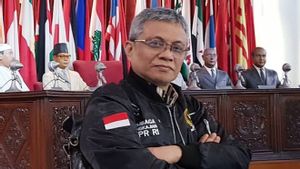JAKARTA - Option to use carbon capture and storage technology aka carbon capture and storage (CCS) for Steam Power Plants (PLTU) to cut emissions, is sticking out again. USC SCR (U-SCR) technology at PLTU is considered suitable for implementing this option.
However, according to Executive Director of the Institute Essential for Services Reform (IESR) Fabby Tumiwa, not all PLTUs are suitable for using this technology. Especially, when viewed from the effectiveness of emission reduction and economic value which leads to electricity production costs.
He sees that of the 13 PLTUs that will be retired, judging from age, performance and efficiency, the use of CCS will not be effective. In addition to the expensive investment costs, the implementation of CCS at PLTU has been running for a long time, many have failed because only the carbon numbers are still captured are still low. Instead of succeeding, said Febby, this actually increases the cost of electricity production.
"If the PLTU already uses SCR or USCR technology like in PLTU Suralaya 9 & 10, the use of CCS is new. So, not all PLTUs are suitable for CCS," said Fabby in Jakarta, quoted Tuesday, October 1.
Simply put, the Selective Catalytic Reduction (SCR) technology with Ultra Super Critical (USC) which becomes U-SCR is a technology to reduce nitrogen oxide and nitrogen dioxide, by converting its molecules into water and free nitrogen. The Java 9 and 10 PLTU is the PLTU that adopts USCR technology and has the potential to become the first hybrid plant to use ammonia and green hydrogen in its production process.
Faby reminded, if you want to use CCS technology, the government should pay attention to its economic value. Also the investment that must be disbursed and the source of the investment. Do not let CCS become a burden in the cost of producing electricity (BPP).
Indef researcher Abra Talattov said the electric BPP from PLTU was among the cheapest. To answer the challenges regarding pollution, he suggested that PLTU implement various technologies to reduce emissions, including super critical coal plants and co-firing.
"Then of course, the consideration of investment costs is also whether it is still economically sufficient to be borne by PLTU to implement the technology, because do not let the impact on BPP increase dramatically," he exclaimed.
Abra continued, when it comes to electricity sources, of course we must be consistent with existing planning, one of which is through the General Plan for National Energy (RUEN) and the Electric Power Supply Business Plan (RUPTL).
"This means that from the existing conditions of the generator, including PLTU, the government must be able to maintain its reliability, capacity, so that it can be utilized, utilized as optimally as possible to be able to provide reliable electricity supply and also most importantly support the provision of affordable, affordable electricity, because the electricity BPP from this PLTU cannot be utilized, including the cheapest one," he explained.
Coordinating Minister for Economic Affairs Airlangga Hartarto himself gave a signal that the change in the direction of the early retirement policy of steam power plants or PLTUs. He said the operation of coal-fueled power plants was not a problem. The government will develop a carbon storage and capture facility or CCS to reduce carbon emissions in Indonesia. "PLTU is okay. We will develop carbon capture storage," said Airlangga at his office, Jakarta, Wednesday (25/9).
The government is testing the implementation of the facility. CCS is a greenhouse gas emission capture technology, to prevent air pollution from escaping into the atmosphere. Caught emission is then stored underground permanently.
The CCS potential in Indonesia reaches 400 to 600 gigatons, meaning that all emissions in the country can be stored with this technology for 322 to 482 years. The day before, Airlangga also mentioned the PLTU early retirement plan.
Early retirement of PLTU is one of the government's policies to accelerate the energy transition. This plan is now experiencing problems, due to the huge cost requirement. Based on a study by the Institute for Essential Services Reform (IESR), the cost for early retirement of PLTU reached US$ 4.6 billion (around Rp 69.5 trillion) until 2030 and US$ 27.5 billion (around Rp 415.7 trillion) until 2050.
BACA JUGA:
Similarly, Minister of Energy and Mineral Resources (ESDM) Bahlil Lahadalia emphasized that the government will make a number of efforts in terms of utilizing coal as a fuel for power plants in line with Net Zero Emission (NZE) policy commitments. Several concrete steps that will be taken include reducing coal utilization in stages, and the implementation of Clean Coal Technology (CCT) at power plants that are still operating.
"Coal will still have its role in accordance with our energy mix. However, in order to get to Net-Zero Emission, it will be supported by environmentally friendly policies, investments and technology of Steam Power Plants (PLTU)," said Bahlil.
The Ministry of Energy and Mineral Resources (ESDM) said that the application of Ultra Super-Critical (USC) technology to Steam Power Plants (PLTU) is included in the roadmap for reducing greenhouse gas (GHG) emissions from the energy sector.
He explained, related to the PLTU policy, the government is currently preparing a roadmap for early retirement of PLTU based on Presidential Regulation (Perpres) 112 of 2022 concerning the Acceleration of Renewable Energy Development for the Provision of Electricity. Meanwhile, for the PLTU that operates, CCT technology will be implemented through the implementation of supercritical and ultra-supercritical technology.
The English, Chinese, Japanese, Arabic, and French versions are automatically generated by the AI. So there may still be inaccuracies in translating, please always see Indonesian as our main language. (system supported by DigitalSiber.id)














